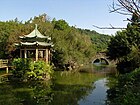Moon bridge
 | |
| Ancestor | Arch bridge |
|---|---|
| Carries | Pedestrians |
| Material | Stone, brick, and wood |
A moon bridge (月桥) is a highly-rounded arched pedestrian bridge .The moon bridge originated in China and was later introduced to Japan.[1][2][3]
This type of bridge was originally designed to allow pedestrians to cross canals while allowing the passage of barges beneath. When constructed using the climbing ascent and descent, it has the further advantage of not using space from the adjoining fields for approaches to the bridge.
In formal garden design, a moon bridge is placed so that it is reflected in still water. The high arch and its reflection form a circle, symbolizing the moon.

Shuangxi Park and Chinese Garden Taipei

Bridge reflecting in the lake in the evening (Dunedin Chinese Garden)

A full circle forms due to the shape and reflection of Engetsu-kyō stone bridge at Koishikawa-Kōrakuen in Tokyo, Japan
See also[]
References[]
- ^ Boults, Elizabeth; Sullivan, Chip (2010). Illustrated history of landscape design. Hoboken, NJ: J. Wiley. p. 118. ISBN 978-0-470-28933-4.
- ^ Ono, Kenkichi; Edwards, Walter. "full-moon bridge 偃月橋・円月橋". Japanese Garden Dictionary: A Glossary for Japanese Gardens and Their History. Retrieved 2 September 2011.
- ^ Bernal, Peggy Park (1999). The Huntington Library, Art Collections, and Botanical Gardens. San Marino, California: Huntington Library. p. 23. ISBN 9780873281348.
Moon bridges were a feature of Chinese garden architecture, adopted by the Japanese in the thirteenth century. The large, rounded bridge is usually known as a moon bridge because the arch and the reflection in the water below form a full form a full moon shape, and also because “moon viewing” from beneath the bridge was a diversion for estate owners cruising on their private lakes.
| Wikimedia Commons has media related to Moon bridges. |
- Footbridges
- Bridges by structural type
- Deck arch bridges
- Garden features
- Chinese gardening styles
- Japanese style of gardening
- Architecture stubs
- Bridge (structure) stubs
- Building and structure type stubs




